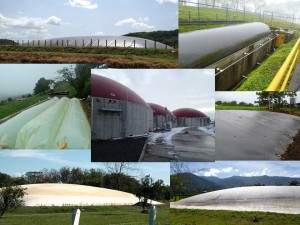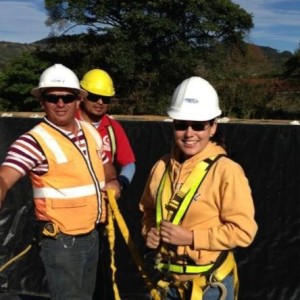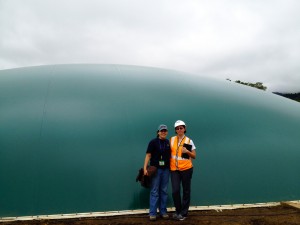Closing the energy gap in Costa Rica
Every time you flick on a light switch or plug in a laptop in Costa Rica, 93% of the electricity surging through your electronics was produced from renewable resources. This tiny nation that EARTH University calls home is an exemplary leader in renewable energy, relying heavily on hydroelectric, solar and wind power, and has an ambitious goal of becoming the world’s first carbon neutral country by 2021. Finding non-conventional renewable energies remains a wide-open field, and EARTH alumna Carolina Hernandez Chanto (’09, Costa Rica) holds the reins to one of the most promising technologies in the race to close the gap: biogas.
Carolina is the coordinator of the Biogas Program at the Costa Rican Electricity Institute (ICE), the government-run company that supplies all of the country’s power. Currently, ICE’s Biogas Program has more than 30 projects throughout the nation, ranging from simple biodigesters for small-scale farmers to industrial anaerobic plants that convert biogas into electricity for the power grid. Regardless of size, they share the same task of using microorganisms to digest biomass (both solid and liquid) and then capture the methane and other gases produced during the process.
EARTH is where Carolina was first introduced to biogas technology.
“When I was at EARTH my mentor was Raul Botero [EARTH professor of integrated animal production] and I really appreciate how much he taught me about biogas systems during my third year,” she remarks, adding: “I was so interested in biogas, I made it my graduation project.”
After graduating, Carolina accepted a research opportunity with Tuskegee University in Alabama designing hydrogen sulfide filters, a key component of biodigester systems that are often extremely expensive.
“I wanted to find ways to make them more affordable, because they are essential for the system to work, but are far too expensive for small producers,” she explains. The university asked her to stay for an entire year, but she turned it down to return to Costa Rica and apply her talents in her home country.
She was hired by ICE as a Biogas Program assistant in 2011, and began consulting with small farmers across the country evaluating, customizing and installing biodigesters that produce gas suitable for cooking and heating. Starting out with smaller and more manageable digesters allowed her to gain practical experience with the often complicated components, giving her the confidence to start tackling larger projects.
Just six months after Carolina started at ICE, she was asked to replace the departing coordinator of the Biogas Program. She jumped at the chance and was particularly excited about the challenge of mastering more recent technology that allows biogas to be converted into electricity.
“Previously, the only the way to use biogas was to burn it, for cooking or heating pipes in a dairy farm. The technology to turn biogas into electricity is a lot newer and requires a huge amount of biomass, at least 1000 kilograms of manure,” she explains
Carolina takes her leadership role seriously and is dedicated to staying on top of current research, saying, “In my position, it’s really important to keep learning and attending classes. ICE has helped me get in a lot of courses and consulting work so I can learn more about lagoons and digestion systems.”
For classes about biogas, Carolina looked to REN@EARTH at the Center for Research and Development of Renewable Energies (CIDER) at EARTH, a joint program between EARTH and the Renewable Energies Academy in Berlin funded by the German government. Earlier this year, she completed the course, “Biogas for Industrial and Community Projects.”

Not all biodigesters are the same; they must be customized to accomodate the type and quantity of biomass, the location and budget, among other things.
In addition to her classroom hours, Carolina went overseas to attend Germany’s largest biogas exposition as well as tour the country’s many industrial biogas plants, courtesy of the Germany Society for International Cooperation (GIZ), facilitators of REN@EARTH.
Her position is unique in that it brings her in contact with people from all walks of life.
“I love my job, I really like talking to producers, many of them don’t know how to read or they have all the materials they need for a system but the just don’t have the information. Some days, you have to get out an Excel sheet and talk numbers and dividends and return of investments with industrial clients. Other days you need to put on your boots and shovel out a dairy barn, explaining to a producer how their dirty water can actually help them,” reflects Carolina.

“I love my job…some days, you have to get out an Excel sheet and talk numbers and dividends and return of investments with industrial clients. Other days you need to put on your boots and shovel out a dairy barn, explaining to a producer how their dirty water can actually help them.” -Carolina Hernandez Chanto (’09, Costa Rica)
The most satisfying part of the job, according to Carolina, is surprisingly simple:
“The best out of everything is seeing the face of the producers when the system starts working. The first time they hear the buzz of their generator and burn their own biogas, their face just says ‘Wow!’”







Awesome! EARTH University is the place to be 🙂
My greatest passion is this. I would love to personally contact Carolina for some more information if anyone has the contacts.
Hola le felicito, en verdad eres una lider brillante Carolina. Saludos desde Honduras promocion 2005
Hola Carolina,
Te felicito por tu animo para hacer que todo el mundo debe hacer, evitando que demasiado metano se mete en la atmosfera.
Estoy escribiendo un articulo, justo sobre la promocion de estas instalaciones
Guadalajara, Mexico
Saludos Carolina. La felicito por su acertada carrera.
Me urge construir un biodigestor para suplir las necesidades de gas y energía eléctrica en un pequepo proyecto de lechería cercano al puente de La Amistad, sobre el Río Tempisque.
Mantengo el ganado en confinamiento de 5:00 A.M. a las 4:00 P.M, Él exceso de boñiga me dificulta el manejo, por lo que un biodigestor resolvería mi problema. Necesito Asesoría y acompañamiento sobre este proyecto.
Comunicación al fax 26 85 43 97 o a la direccción electrónica bufeteebadilla@gmail.com, dirección física: 150 metros Sur Estadio Chorotega. Nicoya – Gte.-
Gracias.
Carolina,
La felicito por todo lo que ha logrado hacer en el tema del biogás. Es impresionante ver las imágenes de los proyectos. Que Dios pueda seguirle guiando y bendicioendo en lo que hace. Un saludo desde Honduras.
Osman Echeverría
Promoción 2005